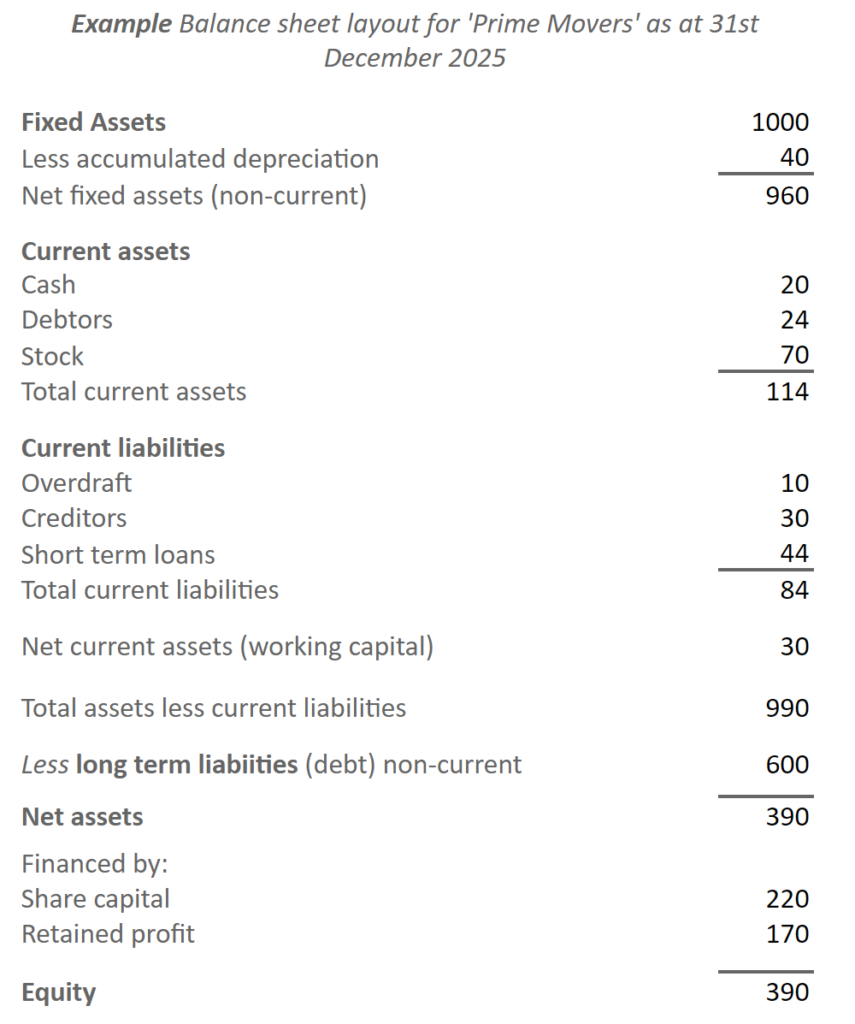Unit 3.4 Business Management
Unit 3.4 Balance Sheet
BALANCE SHEET
A balance sheet contains information on the value of a business’s assets, liabilities and the capital invested by the owners.
The ‘flow’ of the balance sheet follows a set format, which is exemplified below for a business, named, ‘Prime Movers’.



Before you create a balance sheet, it’s worth knowing which items appear on the balance sheet and why.
BALANCE SHEET QUESTION #1

- Explain why a balance sheet is sometimes described as a ‘snapshot’ of a business? [2]
- Explain the difference between an asset and a liability (giving one example of each) [4]
- Categorize (using the table above) how each balance sheet term is classified [13]
BALANCE SHEET QUESTION #2
One of the common questions requires you to ‘construct a balance sheet from the data‘! However, the exam often gives you terms from both the Trading Profit and Loss account and the Balance Sheet, mixed together! This is deliberately confusing and so you must know the difference!


- Categorize (using the table above) how balance sheet terms are classified [13]
- Explain one reason why depreciation needs to be recorded on the balance sheet [2]
BALANCE SHEET QUESTION #3
Shanghai Super Bikes is a modest sized family business. The company’s financial data can be found below for 31st April, 2025
Property: $315,000. Machinery and vehicles: $115,000, Depreciation: $72,000, Stock: $15,000, Cash: $6,000, Debtors: $8,000, Overdraft $6,500, Loan Capital: $190,000, Share Capital: $150,000, Retained Profit: $40,500

- Using the data above, construct a balance sheet for Shanghai Super Bikes [6]
BALANCE SHEET QUESTION #4
A supplier of motorcycle parts (Precision Parts Inc) provides two years of balance sheet details (below) as at July 2025. It is felt that two years data is more interesting / useful for potential investors as they have a benchmark on which to compare! All figures in $000’s
Bank overdraft 40, Cash 80, Creditors 200, Debentures 200, Debtors, 200, Fixed assets, 1000, Long term liabilities 320, Retained profit 300, Share capital 600, Stock 380
Bank overdraft 80, Cash 100, Creditors 200, Debentures 200, Debtors, 280, Fixed assets, 1000, Long term liabilities 200, Retained profit 300, Share capital 800, Stock 400

- Explain how a brand could be considered as an intangible asset [2]
- Using the data above, construct a balance sheet for Precision Parts Inc [8]
BALANCE SHEET QUESTION #5
A small electronics company (SEC) has provided its balance sheet information for the year 2025. All data is supplied in $000’s for July.
Cash $64, Creditors $90, Mortgage $254, Overdraft $60, Property $700, Retained profits $200, Share capital $350, Stocks $120 and Debtors $70
SEC believes it has a loyal customer base which it has built over previous years. SEC considers this customer loyalty to be one of its biggest assets!

- Explain briefly how customer loyalty could be considered an intangible asset [2]
- Using the data provided, construct a balance sheet for SEC [6]
- Define the term share capital [2]
KEY TERMS FROM THE QUESTION
SUGGESTED ANSWERS TO 3.4 BALANCE SHEET #1, #2, #3, #4 & #5
BALANCE SHEET 1
Explain is a balance sheet described as a ‘snapshot’ of a business? [2]
A balance sheet is like a quick selfie of a business’s financial health at a specific moment in time. It captures what the business owns (assets), what it owes (liabilities), and the residual interest of the owners (equity) at a particular date. It’s a frozen frame that gives you a clear picture of the business’s financial position without worrying about the dynamic changes that occur over time.
Explain the difference between an asset and a liability (giving one example of each) [4]
Asset: Assets are resources that a business owns and can use to generate future economic benefits. An example would be something like a company’s machinery or a fleet of vehicles. These are valuable resources that contribute to the company’s ability to produce goods or services.
Liability: Liabilities, on the other hand, are obligations or debts that a business owes to external parties. An example could be a bank loan that the company needs to repay. It’s a commitment to transfer economic benefits (usually money) in the future.
Categorize (using the table above) how balance sheet terms are classified [13]

BALANCE SHEET 2
Categorize (using the table above) how balance sheet terms are classified [13]

Explain one reason why depreciation needs to be recorded on the balance sheet [2]
Recording depreciation on the balance sheet is crucial because it reflects the decrease in the value of a company’s long-term assets over time. This is essential for providing a more accurate representation of the business’s financial position. By accounting for depreciation, the balance sheet recognizes the reduction in the asset’s value, which, in turn, affects the owner’s equity and the overall financial health of the business. It ensures that the balance sheet aligns with the economic reality of the company’s asset values as they wear out or become obsolete.
BALANCE SHEET 3
Using the data above to construct a balance sheet for Shanghai Super Bikes [6]

BALANCE SHEET 4
Explain how a brand could be considered as an intangible asset [2]
A brand (that is successful) can be considered as an intangible asset because it has value. The customers potential customers ability to recognise the brand enables the product or service to be differentiated in the customers mind. This confers a benefit in terms of charging higher prices or encouraging repeat purchases!
Using the data above to construct a balance sheet for Precision Parts Inc for the two years [8]

BALANCE SHEET 5
Explain briefly how customer loyalty could be considered an intangible asset [2]
Customer loyalty indicates a propensity for the consumer to purchase and re-purchase the service / product being offered! Customer loyalty is considered an intangible asset because it creates goodwill, repeat purchases and may in some cases allow for higher prices to be charged.
These customers do not need to be advertised to or marketed to in the same way that new customers do! Loyalty can endure and turn into a long term relationship which confers additional benefits to SEC.
If a business is sold (such as SEC) customers may go with the brand which confers an advantage to the new owners!
Using the data provided, construct a balance sheet for SEC [6]

Define the term share capital [2]
Share capital refers to the total value of capital raised by a company through the issuance of shares.
Shares represent ownership in the company, and shareholders are the individuals or entities who own these shares.
Share capital is a key component of a company’s equity and is used to fund its operations, investments, and other financial needs. It’s an important concept for understanding the financial structure and ownership of a business.





